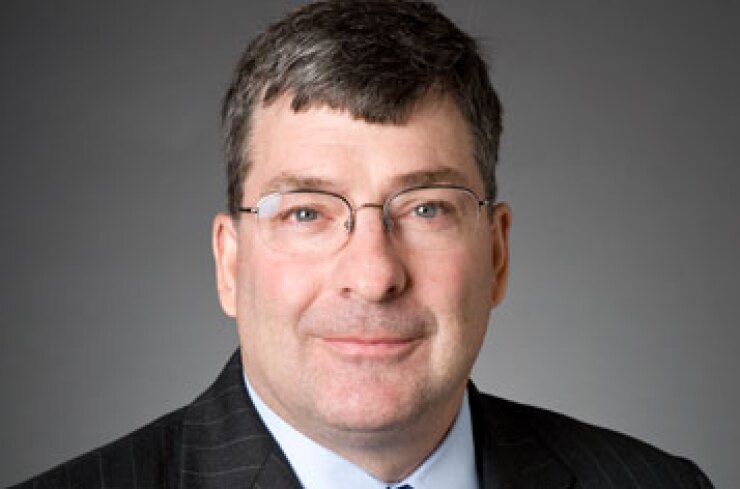
Municipal strategists are recommending non-traditional ways to manage the risk of rising interest rates after a surge in the price of short-term bonds.
While some strategists still recommend shorter-term bonds that provide flexibility if rates jump, others are saying intermediate maturities appear more attractive, and some are even telling investors to look 20, even 30 years out on the curve.
"We think the long end of the curve - which the Barclays index defines as 22 years and higher - is more attractive than the short and intermediate points of the curve," Thomas Weyl, a director at Barclays Capital, said in an interview.
Federal Reserve chair Janet Yellen fueled interest-rate concerns Wednesday when she indicated that the Fed would end quantitative easing in October, and probably would raise interest rates about six months later in April 2015. Prior to her speech, investors had predicted the Fed wouldn't raise interest rates until the third or fourth quarter of 2015.
Municipal bond prices for the short and intermediate parts of the curve fell consistently for the four days following Yellen's speech. By Monday's market close, yields for short-term bonds had risen as much as 29 basis points and intermediates up to 20.
Historically, strategists have told investors to purchase short-term bonds to protect against rising interest rates because shorter maturities offered security against duration. This year-low issuance has driven the spread between five-year triple-A munis and Treasuries to the lowest levels in the last two years. The spread plummeted to negative-58 on Jan. 22 and was negative-40 on March 24.
The short end of the curve has become so costly that strategists are wondering if the expense is worth the safety that shorter maturities provide, and now are promoting an array of different hedging models.
"We still believe there is value in long munis given rich valuations at the short to intermediate part of the muni curve," Barclays said in a report Wednesday. With five-year muni ratios below 70% and 10-years near 70%, long ratios are "relatively cheap" at 102%, the report said.
"This year, 30-year munis have done fantastically well, as duration in general has done well," said Sean Carney, a municipal strategist at BlackRock. "If you look at duration-based indices, long duration is outperforming year-to-date."
On the long-end of the curve Barclays says investors should look at tripleB-rated munis because triple-Bs have outperformed higher-rated bonds, and because of 2014's steady muni inflows.
High-yield municipal funds reported inflows for the ninth consecutive week in the week ended March 19, according to Lipper FMI data. Inflows were $151.9 million for the week ending March 19, and $272.3 million for the week ending March 12.
"Inflows at high-yield muni funds have been strong so far this year, which supports the lower quality part of the market, including triple-Bs," Weyl said.
Barclays additionally notes that even when Puerto Rico-related downgrades are not taken into account, triple-B bonds still offer value because they continue to trade at relatively wide levels.
Excluding Puerto Rico bonds, the firm estimates the yield differential between the triple-B index and the broader muni index declined 10 basis points, to 155. "The adjusted differential is at 70 to 80% of the one-year range of differentials, suggesting there is some relative value in triple-B bonds," the report said.
Weyl said that Barclays is staying away from short and intermediate durations because it expects those parts of the curve to underperform.
Other strategists favor bonds with intermediate maturities, since their prices have been lower than short-term bonds this year and they do not come with as much duration as long-term bonds.
Bernard Garruppo, chief executive officer at Granite Springs Asset Management, said earlier this month that the 15 to 20-year part of the curve makes sense. If investors stay in the 15-year range and rates begin to go up, he said, their portfolios do not have too much duration and are still protected.
Morgan Stanley favors a strategy that John Dillon, chief municipal strategist, described in an interview as "just short of intermediate".
Morgan Stanley said in a report Friday that muni investors should focus on bonds with 5% or higher coupons with short maturities, and that the four- to nine-year range has the most value.
"Keeping in that four-to-nine-year range balances getting some return in the near term with lessened risk in the long term," said Dillon. "It's the intermediate between outsized interest-rate risk and getting a decent coupon." The 5% coupon is important, because you do need to be defensive in this market. It would not take all that much to get us to higher yields, as we saw at the end of last year."
Dillon said that Morgan Stanley is not looking out longer on the curve because it expects 10-year Treasury yields to migrate back to 3%, and investors will start to feel pressure on the long end. The firm expects stronger economic data after the effects of harsh winter weather fades, he wrote in an email.





